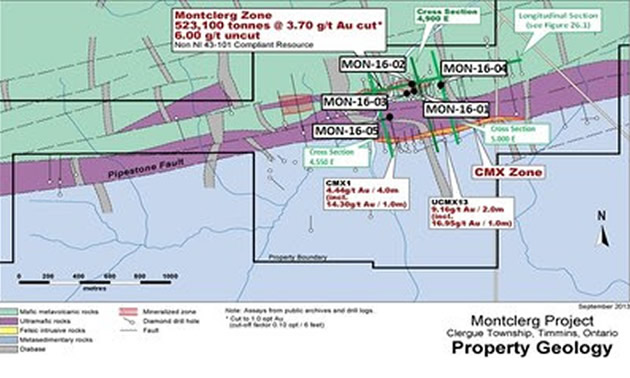International Explorers and Prospectors Inc. announces results from Diamond Drilling program

Map of Montclerg Property. — Photo: International Explorers and Prospectors Inc.
TIMMINS, ON, Feb. 27, 2017 /CNW/ - International Explorers and Prospectors, a privately-owned company incorporated in Ontario ("IEP"), is pleased to announce results from its diamond drilling programs near Timmins, Ontario. These programs were funded by the Junior Exploration Assistance Program ("JEAP") administered by the Ontario Prospectors Association ("OPA").
During the past months IEP completed diamond drilling programs totalling 3,965 metres on two properties funded by JEAP grants. IEP received most of the financing through the strategic sale of royalties on three advanced properties in the Timmins Camp to Metalla Royalty and Streaming Inc. (CES:MTA). As per the terms of the JEAP agreement, IEP can receive up to 33.3% refund on approved exploration expenditures on two properties up to a maximum of $100,000 on each property.
The company completed drilling programs on its Montclerg gold property and confirmed the presence of wide intersections of potentially openpitable gold mineralization and on its Genex Property where VMS-type stringer mineralization was tested and confirmed wide intersections. Mr. Lionel Bonhomme, President of IEP commented: "We are pleased with the results of the two programs because they confirmed what we were expecting. At Montclerg we are confident to be able to delineate an openpitable resource and we are happy to see that the Mise à la Masse survey confirms that the high grade Grey Zone altered mineralization comes up to surface in the iron-rich basalts next to the low grade felsic volcanics and this will help the economics of the low grade mineralized system."
On the Monteith Project, which includes the Montclerg Property, IEP carried out an airborne geophysical survey and a five hole, 1,907-metre diamond drilling program.
The Montclerg Property is underlain by the Main Zone which has a historical resource of 523,000 tonnes tonnes grading 3.7 gpt gold (cut to 30 gpt Au) or 6.0 gpt Au (uncut) using a lower cut-off of 3.4 gpt Au and a minimum width of 1.8 metres (figure 1). Refer to the disclaimer on Historic Resources at the end of this News Release. The estimate by A.S. Bayne, P.Eng. in 1985 was done for Consolidated Montclerg Mines Ltd. More recently in 2006 we drilled a series of vertical holes, crossing the Main Zone and penetrating to 350m where sulphide-rich gold veins were encountered in iron-rich basalts between the ultramafic rocks and a felsic volcanic complex, demonstrating the long-held belief that the gold system in the Main Zone is dominated by shallow dipping mineralized gold-bearing structures.
Drilling of four holes on the Main Zone in 2016 has confirmed that the felsic volcanic complex is host to low grade gold mineralization over widths and depths that could be amenable to openpit exploitation and that the iron-rich basalts in the footwall between the felsic volcanics and ultramafic complex to the south contain high grade gold minerlization. Highlights of the composite intervals are shown in table 1. Results include an interval of 123.5 m in hole MON-16-01 which assayed 0.74 gpt Au, including a 45.0 metres interval which assayed 1.12 gpt Au and a 87.0 metre interval in hole MON-16-02 which assayed 0.78 gpt Au, including 28.5 metres which assayed 1.11 gpt Au. At depth in the iron-rich basalts near the contact with the felsic volcanics hole MON-16-04 assayed 5.54 gpt Au over 1.8 m within a wider interval of 4.8 meters at 3.01 gpt Au. Further down the hole a 9.1 metre interval assayed 2.1 gpt Au which included a 1.5 m sample at 7.54 gpt Au.
Hole MON-16-05 was drilled on the Canamax zone and intersected a porphyry unit at the contact between the ultramafic complex and the Porcupine sediments to the south. At the porphyry-sediment contact the hole returned 1.1 gpt Au over 1.5 metres.
Mineralization in the felsic volcanic complex is related to intense micro-fracturing of the rock and up to a few percent disseminated arsenopyrite and pyrite. Higher gold grades appear to correlate with greater sericitization and iron-carbonate alteration and a higher abundance of pyrite. In the iron-rich basalt the gold mineralization is found in Grey Zone altered zones composed of graphite and muscovite that contain up to semi-massive pyrite over short intervals.
"Our future efforts on the Montclerg Property will focus on systematically expanding the low grade gold mineralization in the felsic volcanic complex in an effort to delineate an openpitable resource", commented Charles Beaudry, V.P. Exploration and Director of IEP and Qualified Person for this release.
He added, "We also plan to carry out near surface drill testing for Grey Zone alteration structures in the iron-rich basalts at the south contact of the felsic volcanics. There is ample evidence from the historic drilling that the low grade zone can be extended over 450 metres along strike and that the mineralization in the iron-rich basalts has been followed intermittently for over 500 metres and extends to depths of at least 350m vertical".
On the Kamiskotia Project, which includes the Genex and Godfrey township properties along with the Turnbull and Carscallen properties, the work program comprised a deep-penetrating airborne VTEM™ survey to detect deeply buried VMS targets within the Godfrey, Turnbull and Carscallen township areas which are part of the Blake River and Kidd Munro Assemblages, respectively. On the Genex Property IEP undertook an 8-hole diamond drilling program totalling 2,058 metres (figure 2).
At Genex, a polymetallic sulphide deposit was mined on a small scale in the 1960's when an onsite mill produced 242 tonnes of concentrate at a grade between 21 to 27% Cu from an existing reserve totaling 120,600 tonnes at 2.22% Cu (MNDM, OFR5118). Refer to the disclaimer on Historic Resources at the end of this News Release. The zone is part of a syn-volcanic stringer zone complex in felsic and mafic volcanic rocks (MNDM, OFR6156). Drilling by IEP in 2000 to directly test the stringer mineralization intersected high grades over short intervals and, in addition, broad low grade intervals including EGG32-30 (6.67% Zn, 1.40% Cu, 0.26% Pb and 12.0 gpt Ag over 2.9m starting at 12.85m), EGG32-37 (4.03% Cu, 0.18% Zn and 0.37 gpt Au over 2.95 m starting at 20.0m) and EGG32-36 (0.46% Cu, 0.87% Zn, 6.6 gpt Ag, and 0.13 gpt Au over 24.1m).
A recent (2014) induced polarization survey identified a major chargeability anomaly on the Genex property that encompasses the old mine (A and H zones) and has been interpreted by IEP's geological and geophysical staff to represent a broad VMS stringer zone. The chargeability anomaly measures approximately 600 by 500m and the interpretation suggests that syn-volcanic mineralization occurs in two ENE-trending structures separated by a NS trending stratiform horizon that corresponds to the C-Zone. The drilling was oriented to intersect the stringer zones at high angle to test for a near surface, open-pitable resource.
Results of the drilling confirm the broadly distributed low grade mineralization in the volcanic rocks that coincides with the IP chargeability anomaly previously outlined on the property. Analytical results are summarized in table 2 below.
The best results from the program include a 14.4 m interval in hole GEN-16-02 which assayed 0.31% Cu, 0.22% Zn and 0.21 gpt Au, hole GEN-16-03 which assayed 1.25% Zn, 0.04% Cu and 0.31 gpt Au over 9.4 metres.
The local geology consists of a north trending, steeply east dipping, east facing sequence of mafic and felsic volcanics with some syn-volcanic, peperitic intrusions and cut by a number of late, north trending diabase dikes. The mafic units often form pillowed flows with well-developed flow-top breccias and the felsic units are typically fragmental to pyroclastic in nature. Although the units trend north-south the stringers zones trend in a ENE direction and clearly cross-cut the local stratigraphy and form a classic VMS vent system. Alteration is locally intense and correlates well with better base metal and gold grades. The best alteration and the highest grades and widest mineralized intervals occur in the fragmental rocks presumably because of greater permeability.
The drilling program confirmed the source of the IP chargeability anomalies and results provide encouragement that a low-grade openpitable resource can be delineated by drilling on the Genex property. Future exploration efforts will be oriented towards establishing an open pitable resource on the Genex property, particularly on the north vent system where it extend eastward, up section, towards the Gossan massive sulphide target, which could not be tested in this program.
Charles Beaudry, P.Geo, V.P. Exploration and director of IEP is the qualified person responsible for this release.




